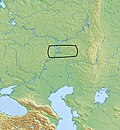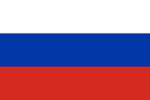The Sintashta culture is a Middle Bronze Age archaeological culture of the Southern Urals, dated to the period c. 2200–1900 BCE. It is the first phase...
46 KB (4,908 words) - 14:33, 20 October 2024
Sintashta is an archaeological site in Chelyabinsk Oblast, Russia. It is the remains of a fortified settlement dating to the Bronze Age, c. 2800–1600...
7 KB (751 words) - 16:05, 24 October 2024
Iranian peoples (section Sintashta–Petrovka culture)
migrations from 800 BC onwards. The Sintashta culture, also known as the Sintashta–Petrovka culture or Sintashta–Arkaim culture, is a Bronze Age archaeological...
117 KB (12,400 words) - 09:06, 2 November 2024
Aryans. The Proto-Indo-Iranian-speakers are generally associated with the Sintashta culture, which is thought to represent an eastward migration of peoples...
25 KB (2,726 words) - 02:28, 30 October 2024
archaeological complex or archaeological horizon. The slightly older Sintashta culture (c. 2200–1900 BC), formerly included within the Andronovo culture...
63 KB (7,092 words) - 03:42, 2 November 2024
Proto-Indo-Iranian-speaking. It played a major role in the development of the Sintashta culture and Srubnaya culture. The Abashevo culture is believed to have...
25 KB (2,936 words) - 21:10, 23 October 2024
appears to have influenced the ceramics of the Abashevo culture and the Sintashta culture. Evidence of early composite bows have been yielded from the Catacomb...
28 KB (3,353 words) - 14:11, 20 October 2024
developed on the Central Asian steppes north of the Caspian Sea as the Sintashta culture (c. 2200-1900 BCE), in present-day Russia and Kazakhstan, and...
236 KB (27,680 words) - 08:57, 2 November 2024
the Sintashta culture, suggesting that the Sintashta culture emerged as a result of an eastward expansion of Corded Ware peoples. The Sintashta culture...
79 KB (9,108 words) - 03:41, 18 October 2024
Arkaim (category Sintashta culture)
fortified archaeological site, dated to c. 2150-1650 BCE, belonging to the Sintashta culture, situated in the steppe of the Southern Urals, 8.2 km (5.10 mi)...
15 KB (1,724 words) - 00:47, 30 October 2024
as the peoples of the Sintashta, Andronovo, and Srubnaya cultures. Back migration from Corded Ware also contributed to Sintashta and Andronovo. In these...
68 KB (7,012 words) - 14:21, 25 October 2024
Chelyabinsk (section Ancient Sintashta civilization)
Chelyabinsk contained the ancient settlement of Arkaim, which belonged to the Sintashta culture. In 1736, a fortress by the name of Chelyaba was founded on the...
60 KB (6,001 words) - 07:27, 17 September 2024
migrations from 800 BCE onwards. The Sintashta culture, also known as the Sintashta-Petrovka culture or Sintashta-Arkaim culture, is a Bronze Age archaeological...
267 KB (29,484 words) - 08:57, 2 November 2024
culture, all of whom shared genetic affinity with the Yamnaya culture. The Sintashta culture and Andronovo culture of Central Asia also displayed close genetic...
20 KB (2,476 words) - 13:25, 2 May 2024
It had close relations with the Sintashta culture in the east, with whom it shares many similarities. Like the Sintashta culture, its people are believed...
16 KB (1,841 words) - 07:37, 11 April 2024
Spoke (category Sintashta culture)
vehicles. The earliest physical evidence for spoked wheels were found in the Sintashta culture, dating to c. 2000 BCE. Soon after this, horse cultures of the...
14 KB (1,793 words) - 08:36, 31 December 2023
the Abashevo culture, which in turn contributed to the formation of the Sintashta culture. The Fatyanovo–Balanovo culture ended about 2050 BC. The Fatyanovo...
24 KB (2,795 words) - 21:24, 31 October 2024
Chariot (category Sintashta culture)
motive power. The oldest known chariots have been found in burials of the Sintashta culture in modern-day Chelyabinsk Oblast, Russia, dated to c. 1950–1880...
68 KB (8,272 words) - 09:07, 4 November 2024
found to be closely related to people of the Corded Ware culture, the Sintashta culture, Potapovka culture and the Andronovo culture. These were found...
16 KB (1,630 words) - 04:49, 24 October 2024
similarities. Some cultural similarities between the Nordic Bronze Age, the Sintashta/Andronovo culture and peoples of the Rigveda have also been detected....
95 KB (9,933 words) - 13:57, 10 October 2024
forming the Sintashta culture and a type of WSH ancestry often referred to as Steppe Middle and Late Bronze Age (Steppe MLBA) or Sintashta-related ancestry...
56 KB (6,139 words) - 23:34, 23 October 2024
progress eastwards across the Eurasian Steppe. The Sintashta culture in the Ural Mountains, or a "Sintashta-derived" culture (such as the Andronovo), is thought...
50 KB (5,788 words) - 16:31, 31 October 2024
quite different. -2000 EBLA MARI ASSYRIA Jeul- mun Andronovo culture Sintashta culture BMAC Vakhsh Ancient Northeast Asians Tarim mummies Okunev Elunino...
27 KB (2,874 words) - 13:58, 16 September 2024
these steppe civilizations were discovered in places such as Ipatovo, Sintashta, Arkaim, and Pazyryk, which bear the earliest known traces of horses in...
372 KB (33,705 words) - 14:21, 2 November 2024
Gennady Zdanovich, who studied some of the oldest examples of the symbol in Sintashta culture, the swastika symbolises the universe, representing the spinning...
168 KB (17,267 words) - 01:07, 2 November 2024
influenced the later emergence of the Potapovka culture, Abashevo culture, Sintashta culture and Srubnaya culture. The Poltavka culture emerged ca. 2800 BC...
17 KB (2,144 words) - 16:16, 23 October 2024
Poltavka Srubnaya Northern/Eastern Steppe Abashevo culture Andronovo Sintashta Europe Globular Amphora Corded ware Bell Beaker Únětice Trzciniec Nordic...
149 KB (16,668 words) - 20:10, 4 November 2024
Baikal hunter-gatherers with varying degrees of Western Steppe Herders/Sintashta-like admixture started to appear in the Altai region during the Late Bronze...
50 KB (5,842 words) - 16:52, 14 July 2024
wheel are introduced, as are Cretan hieroglyphs. c. 2100–1800 BC – The Sintashta culture emerges in the northern Eurasian Steppe. c. 2070 BC – Yu the Great...
6 KB (666 words) - 05:22, 5 May 2024
Sintashta and Andronovo horizons who were themselves a mixture of ~2/3 Yamnaya-related and 1/3 European farmer-related ancestry4,5,6. The Sintashta-related...
62 KB (6,056 words) - 17:40, 20 October 2024


























